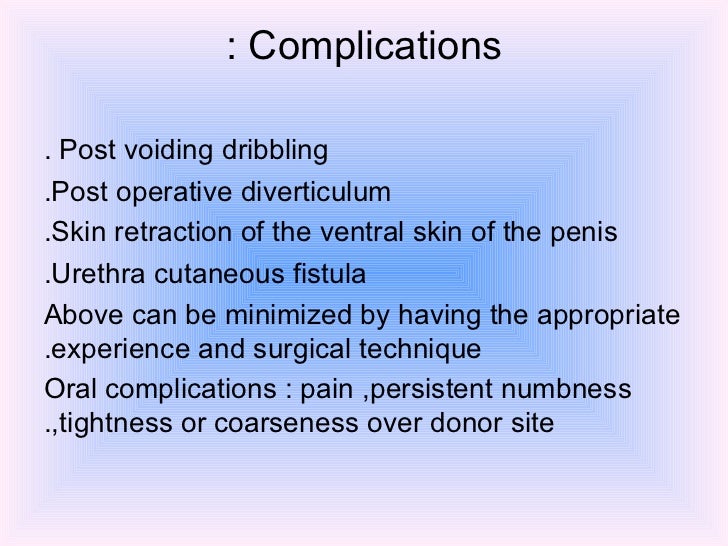
Remember, you are NOT performing a Kegel during urination! This techniques should be performed once the urine stream has ended and only if necessary. This will improve the coordination between the brain, bladder, and pelvic floor. Lastly, perform 5 quick Kegels to remind the bladder that it can relax now.When you sit back down more urine may come out.

If you have a prolapse, this will allow the urine that was in the ‘pocket or prolapse’ of the bladder to shift over the urethra.
#Causes of post void dribbling full#
Teaching your bladder to empty before it is full will lead to bladder dysfunctions including incontinence, urinary frequency, and feeling of incomplete emptying, as well as pelvic pain. Give it time to fill up before your next void, despite the feeling. We do not void 100% of our urine out with each void (normal residual urine is 10%) and our kidneys are constantly making urine, so as soon as you walk away from the toilet, the kidneys started filling the bladder up again. It is important to remember that we always have urine in our bladder, so just because you CAN urinate, doesn’t mean you SHOULD urinate. Teaching your bladder to not empty until it is full (see What is Normal) will allow the brain, bladder, and pelvic floor muscles to coordinate again and the feeling will resolve. Bladder Retraining including following a voiding schedule and water guidelines is the best treatment for this. Often times it is empty, however, due to poor bladder health (diet, voiding habits) and training of the bladder to empty frequently the brain, bladder, and pelvic floor are not getting the proper signals (incoordination) that the bladder has emptied, resulting in the need to urinate often due to feeling of incomplete emptying. This is not to say that the bladder isn’t actually empty yet, it will give the feeling of not being empty resulting in feeling the need to urinate often to ’empty’ the bladder. When the bladder is irritated, emptying will not feel satisfying due to inflammation and incoordination. These symptoms can present an urge to urinate shortly after having just emptied (constant urge to urinate) or post void dribbling (leaking after urination) depending on the reason. This can be due to bladder irritation and incoordination of brain/bladder/pelvic floor, or a bladder prolapse. Post-Void Leaking (leaking after urination)Ī common complaint from women is the feeling of incomplete bladder emptying.Defecation Dyssynergia/Difficulty with Defecation.Hesitancy/Difficulty Starting Urine Stream.Overactive Bladder (OAB)/Frequency/Urgency.Dyspareunia/Pain with Intercourse or Orgasm.Interstitial Cystitis (IC)/Painful Bladder Syndrome (PBS).For older men, they may develop PMD following a prostatectomy and may have associated urinary symptoms. Other signs of urinary dysfunction are not normally present, although some men have symptoms such as urgency, frequency, hesitancy and straining. Constant cough, for example, a smoker’s cough.Continual straining to empty the bowels, especially when constipated.The pelvic floor muscles can be weakened by: PMD is due to a weakness of the muscles of the pelvic floor, which surround the urethra. Men usually find that even after waiting and gently shaking, the problem remains. Trousers and clothes can end up getting wet, causing frustration and embarrassment. However, PMD is likely to occur when the main flow has finished, and clothes are being rearranged after a visit to the toilet. It may be experienced in women, but it is much more common in men. The condition can be a nuisance and cause embarrassment. It is not caused by stress from exertion or due to a problem with the bladder, and it should be distinguished from terminal dribble, which occurs at the end of passing urine. Post-Micturition Dribble (PMD), or after dribble, is the name given to the problem when men experience an involuntary loss of urine immediately after they have finished passing urine, usually after leaving the toilet.


 0 kommentar(er)
0 kommentar(er)
